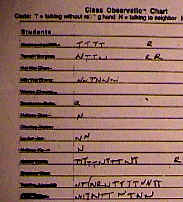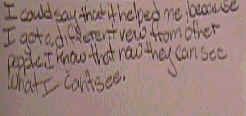|
Our Teacher
Research: Past & Present
Helping
all students achieve higher standards
GETTING
SMARTER AT SCHOOL
A 7th Grade Class
Researches and Reflects on Its Discussion
Habits
by Matt
Wayne M17Wayne@aol.com
|
All across
the nation, schools are asking
their students to meet new and
higher standards in all subject
areas. The new standards require
students to become thinkers and
problem solvers. Thus, we need
to create opportunities in the
classroom for students to be thinking
and problem solving. In my seventh
grade English language arts classroom,
I endeavored to do just that in
our efforts to meet the Speaking
and Listening Standards through
our discussions around our reading
and writing. In our class, the
students were given the responsibility
to think through what it means
to have a good discussion and how
we might accomplish this.
|
Speaking
and Listening Standard
E3b
The student
participates in group meetings
in which the student:
- displays
appropriate turn-taking
behaviors;
- actively
solicits another person's
comment or opinion;
- offers
own opinion forcefully
without dominating;
- responds
appropriately to comments
and questions;
- volunteers
contributions and responds
when directly solicited
by teacher or discussion
leader;
|
|
Thinking To Meet the Standards
 In
the beginning of the year, our first discussions
were unfocused and didn't meet any of the criteria
established in the new standards document.
As I thought about how to address this issue,
I recalled steps I've taken to improve my own
teaching. The use of action research during
the previous school year had greatly helped
my practice. Action research is "research designed
to yield practical results that are immediately
applicable to a specific situation or problem." Or
more simply put, "Action research is a way
of saying, 'Let's study what's happening at
our school and in our classroom and decide
how to make it a better place.'" Having had
success when researching my own teaching practice,
I wondered what would happen if the students
were to research their discussion habits. In
the beginning of the year, our first discussions
were unfocused and didn't meet any of the criteria
established in the new standards document.
As I thought about how to address this issue,
I recalled steps I've taken to improve my own
teaching. The use of action research during
the previous school year had greatly helped
my practice. Action research is "research designed
to yield practical results that are immediately
applicable to a specific situation or problem." Or
more simply put, "Action research is a way
of saying, 'Let's study what's happening at
our school and in our classroom and decide
how to make it a better place.'" Having had
success when researching my own teaching practice,
I wondered what would happen if the students
were to research their discussion habits.
During our next discussion, the student's science
teacher collected data on who raised their
hands (R), who talked out of turn (T), and
who talked to a
neighbor (N). (See excerpt of the class observation chart.) The next day I
presented the data and we worked together to figure out how we could do things
better. After an interesting conversation about the research I collected, the
students suggested several strategies to better focus our talks. They wanted
to make a conscious effort to raise hands and to try not to sit next to friends
with whom they might be tempted to have side conversations. The very next day
there was an excellent example of what can happen when students think through
a problem and take responsibility for their learning. Alana and Kendra had
sat next to each other in the meeting area and had side conversations during
our previous discussion seventeen times! Before class began, Kendra came in
to sit down next to Alana. Instead of chatting with Kendra as usual, Alana
said, "You know what, you probably shouldn't sit there. You know we're going
to talk if you do." Sure enough, Kendra moved and they did a much better job
than the day before. We researched and reflected on our conversations for the
next several weeks and we were able to see a marked improvement in our discussion
habits. (See graph.) This experience made us committed to using the action
research process to improve our discussions throughout the year.

The More We're Asked To Think,
The More We Learn
By March, I was reading aloud a novel to the
class and students were working in book clubs
reading their own books. We held many discussions
about our reading
to help us understand and respond to the text. These conversations that took
place in March bore little resemblance to our work in September and October.
The biggest change was that the students were responsible for the whole discussion
- from their actions as participants to the content of the conversation. After
reading aloud a section of our class novel, the students would propose discussion
topics based on the reading. As half the class had a ten to fifteen minute
conversation about their topics, the other half worked as researches investigating
the discussion. While in September and October we were looking at simple actions
such as raising our hands or talking out, we now investigated more sophisticated
behaviors such as our body language and eye contact. More importantly, we looked
at the content of the discussion and analyzed our topic suggestions, how we
supported our ideas, and how we responded to other people's comments.
| Once
again, the research process offered
students the opportunity to be problem
solvers as they worked to meet the
Speaking and Listening Standards. The
class agreed that doing the research
positively affected both the class'
discussion habits and their individual
role in discussions. |

Alana describes how the research process has helped her discussion
habits. |
Tyrone, a very dominant
speaker, claimed that the research process
helped him "because I saw how other people
can't talk - being outside [the discussion]
makes you see not to talk so much." Shi Fen,
on the other hand, learned the value of talking
more. He said, "doing the research made me
want to talk more. I knew it was important
to share my ideas." A significant number were
also able to make the connection between researching
and reflecting on our class discussions and
their work in the book club meetings. Lolita
shared that the fishbowl helped her "learn
how to express my feelings about the book more
in our book club meetings." Finally, Alana
noted that the research "helped me because
I got a different view from other people. I
know that now they can see what I can't see." Alana
has eloquently defined the research process
which has helped our whole class get a different
view and become thinkers in our work toward
the Speaking and Listening Standards.
Creating an Environment for Thinking Students
and Teachers -
What Policymakers Can Do
Our work to improve our discussions is just one example of how we can encourage
our students to be thinkers and problem solvers, the skills which are necessary
to meet the new standards. Professional development in a school or in a district
can be structured to empower this reflective teaching and learning.
For classroom research to happen, it is essential that teachers:
- develop their own
research questions based on the students'
needs, the
teachers' passion,
and the learning standards the students
are expected to meet. Action research
questions
shouldn't be mandated from outside, but
grow from classroom situations, critical
conversations
between colleagues, and the guidance
of professional developers and instructional
leaders in the
building.
- have the time and the tools in class to
pursue their research. This kind of classroom
research is only effective if it is integrated
into the day-to-day work of the teachers and
the students.
- collaborate with other teacher researchers
and collectively analyze the data and reflect
on their ideas. Releasing teachers to observe
each other's class and providing time to meet
with a professional developer are two such
examples which contributed to my success with
classroom research this year.
For the students, it is important that:
- the research is
recognized as critical thinking essential
to meeting
the new standards.
- the research is
done in a safe environment and in the
spirit of
problem solving.
- students are purposefully collecting data.
- students, just like teachers, are given
the opportunity to collaborate with each other
and share their ideas about the dat
|